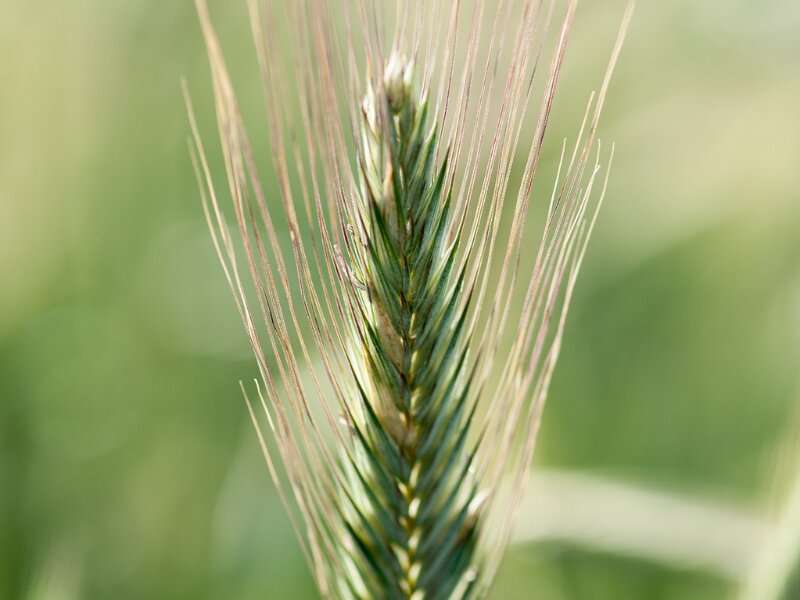Ryes to the occasion: Exploring how winter rye varieties can suit different climates

Understanding how a crop will grow in various places is key to getting more farmers to grow it. Rye is a cereal grain grown in parts of Europe, and although not a commonly grown crop in other regions, its characteristics make it a valuable option for farmers.
Researchers in Estonia, a country in northern Europe, studied how rye grows in Estonia and the United Kingdom. They tested different varieties of rye with different fertilizers. Estonia has colder winters and more snow when compared to the United Kingdom.
“We reported the results of the Healthy Minor Cereals project experiment conducted 2013-2018,” explains researcher Ilme Tupits from the Estonian Crop Research Institute. “The aim was to investigate how winter rye cultivation can be extended to different climatic regions in Europe.”
This research was published in Crop Science, a publication of the Crop Science Society of America.
In the experiment, the researchers grew four different varieties of rye in Estonia and the United Kingdom. The varieties each had slightly different characteristics. Tupits says that to grow well in Estonia, a rye variety must be winter hardy and resistant to snow mold infection.
They applied four kinds of nitrogen-containing fertilizer in two different amounts to the winter rye. Three of the fertilizers, cattle slurry, farmyard manure, and biogas digestate are used in organic farming. The fourth one, mineral nitrogen, is used in conventional farming.
Tupits says that mineral nitrogen is readily available to plants after it is applied in the field. However, nitrogen from organic fertilizers is slowly absorbed by plants over the growing period. “Rye needs less nitrogen than other cereal to form a good yield,” Tupits says. “This is what can make it a beneficial crop. The exact amount of nitrogen in the cultivation of rye depends on the geographical location, weather conditions, the nutrient content of the soil, and the variety grown.”

Their results showed that mineral nitrogen and biogas digestate resulted in higher yield and seed protein content in both Estonia and the United Kingdom. Biogas digestate is material leftover from the production of biogas from cattle manure. Tupits notes it is a good organic fertilizer option for crops like winter rye that have a lower nutrient requirement and for other cereals in organic farming.
Some rye varieties were more winter hardy than others. In addition, some were more resistant to snow mold than others. Snow mold can devastate a farmer’s yield.
Another issue rye growers face is lodging. This happens when the stem of the cereals goes from standing straight up to bending to the ground. This can occur during strong wind or rain and may be due to some disease issues. Some varieties are less likely to experience lodging than others.
It comes down to the specific needs at the growing site, Tupits says. Their research results will help farmers pick the best variety of rye for their area.
“Overall, the quality of the grains really depends on many parameters,” she says. “These depend on the properties of the soil, the air and soil temperature during the growing season, occurrence of plant diseases, and more. Varieties that are suitable for cultivation everywhere do not exist. Farmers select cereal varieties according to the soil and climatic conditions of their location.”
Tupits says this research is a powerful collaboration between scientists and breeders, and the study was meant to help farmers, flour producers, and bread makers. Currently, winter rye is cultivated in only a few countries and bread made from rye is not widely consumed.
Rye bread is a historically traditional food in Estonia, Latvia, Lithuania, Finland, Ukraine, Poland, and Germany. Even though research has shown the many health benefits of rye, many people don’t eat it. “We have offered rye bread to guests at our research institute and visitors are in awe at how delicious it is,” Tupits says. “I believe that more research on rye will help to better organize agriculture and food production for a growing population in a changing climate.”
Getting to the root of how to grow cowpea in difficult conditions
Ilme Tupits et al, Evaluating the effect of nitrogen fertilizer rate and source on the performance of open‐pollinated rye ( Secale cereale L.) cultivars in contrasting European environments, Crop Science (2021). DOI: 10.1002/csc2.20687
Citation:
Ryes to the occasion: Exploring how winter rye varieties can suit different climates (2022, April 18)
retrieved 18 April 2022
from https://phys.org/news/2022-04-ryes-occasion-exploring-winter-rye.html
This document is subject to copyright. Apart from any fair dealing for the purpose of private study or research, no
part may be reproduced without the written permission. The content is provided for information purposes only.
For all the latest Science News Click Here
For the latest news and updates, follow us on Google News.

